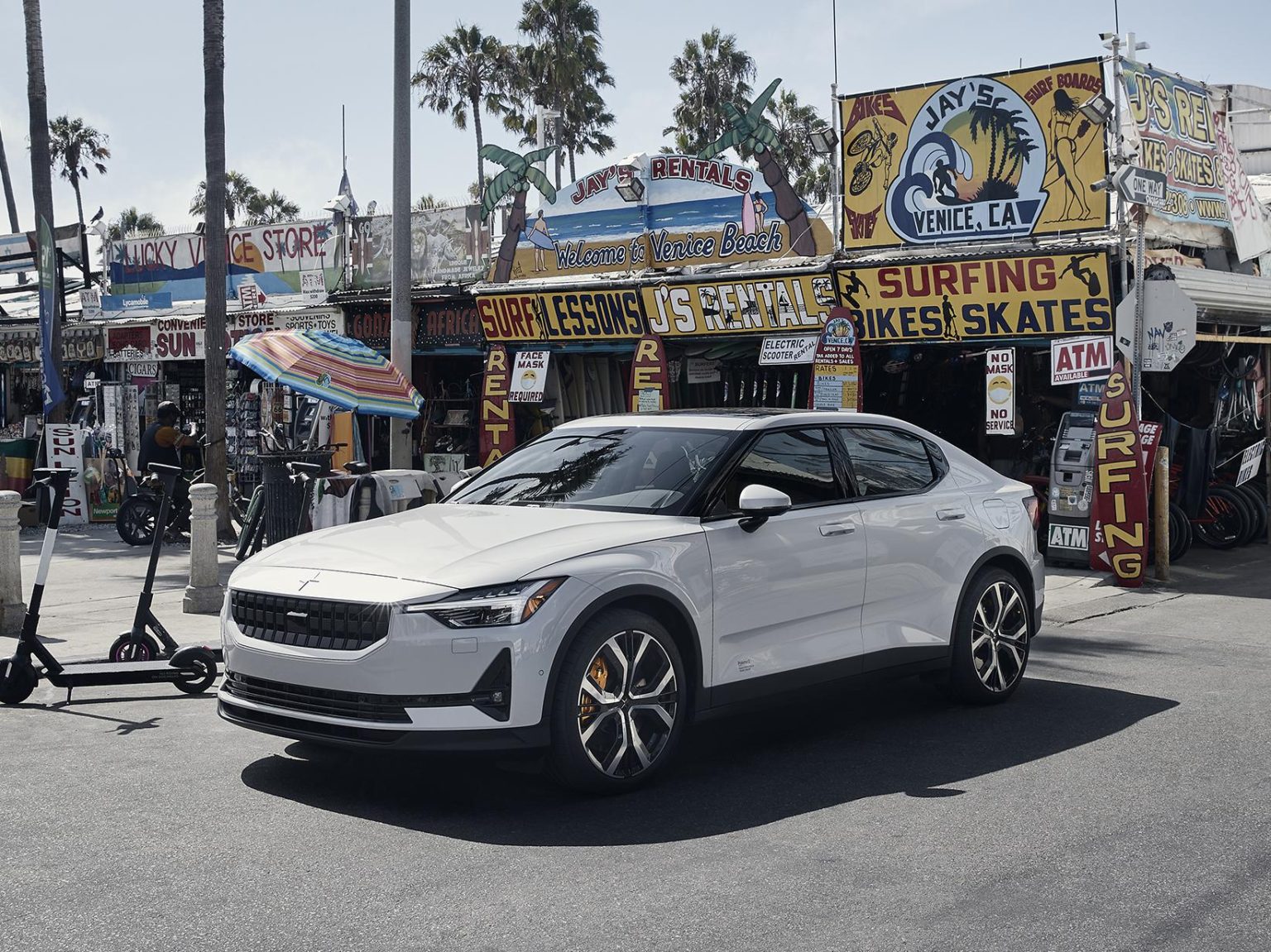I’ve spent a lot of time behind the wheel of various electric cars. Tesla, Hyundai, Chevrolet, and now Polestar — the new electric car brand from Volvo and their parent company Geely.
Polestar began life as a racing team that later built speedy versions of Volvo’s wagons and sedans for folks looking for a more performance-oriented ride. Then Volvo bought the whole company and spun it off as a separate premium brand focused on EVs. It’s not quite the Lexus to Volvo’s Toyota, given that both marques are rather premium — but there are certainly differences even with a lot of shared DNA.
The car is of the fastback design.Photo courtesy of Polestar
Polestar’s first effort was the Polestar 1, a $155,000 grand touring coupe with a 2.0-liter four-cylinder super- and turbocharged engine borrowed from Volvo combined with an all-electric driving range higher than 52 miles and a total of 619 horsepower. Only 1,500 will be made. It’s Polestar’s halo car and you might never see one on the road.
Then there’s the Polestar 2, which the company hopes you’ll see a lot of. It’s a five-door fastback that starts at $59,900 and sports a 78-kilowatt-hour battery. It also has a 233-mile range according to EPA tests, which is a bit lower than competing vehicles — in particular the Tesla Model 3.
But range isn’t everything, and the overall experience of the Polestar 2 is fantastic. First are the looks — it borrows a lot from its Volvo siblings, which is always a good thing. The interior is very Scandinavian, with clean lines and sharp edges. The fully-loaded Launch Edition that I drove sported a vegan textile interior and the brilliant golden seatbelts that are a hallmark of the Polestar brand these days.
The car features a number of golden accents, one of Polestar’s hallmarks.Photo courtesy of Polestar
There was an excellent place to put my phone to charge, in a deep bin set just ahead of the gear shifter. There are two cupholders, but one is covered up by the center armrest and is rather inaccessible. I hope the designers do better next time on that particular element. The seats are comfortable and I’m calling out the manually-adjustable thigh bolster as a worthy feature that every car should have. The rear seats have terrific legroom even though the car isn’t particularly large, thanks to clever packaging and the battery location below the passenger compartment.
Trunk space is incredibly spacious as one would expect in an EV, and there’s an extra bonus storage area under the trunk floor that can be accessed by lifting up on a handle on the floor — and then there’s a cute little kickstand to hold the floor panel up. There is a “frunk” front-trunk, but it’s very small and meant to hold charging cables and the car cover.
It’s also a hoot to drive. The launch edition has the $5,000 Performance Pack fitted, adding adjustable Öhlins dampers, four-piston Brembo brake calipers up front (in gold!), those golden seatbelts, and matching golden tire valve caps which will probably be stolen at the first opportunity.
The interior of the fastback features vegan leather.Photo courtesy of Polestar
Between the two electric motors, the Polestar 2 boasts 408 horsepower and an even-more impressive 487 pound-feet of torque, pushing from zero to 60 mph in under 4.5 seconds. That’s a lot of oomph and like all EVs, the torque is the most intoxicating part. It’ll rocket from 70 mph up and over 100 mph with startling quickness, so watch out when you’re passing on the highway.
I really like EVs. Aside from the (arguable) environmental benefits, they provide instant torque and acceleration, tend to be very safe because of packaging advantages, and, if you charge them at home, you almost never have to go to the gas station unless you’re looking to pick up some Mega Millions or Powerball tickets.Tesla is the king of the roost of EVs of course, and I’ve taken extended drives in the Model S, Model X, and Model 3 — and without question the best feature of a Tesla isn’t the car at all: it’s the company’s network of ultra-fast Supercharger stations.
I used a regular DC fast charger during my time with the Polestar and it was fine. But I had to set up an account with ChargePoint and enter my credit card number and all that, which admittedly I’d only have to do once if I owned the car — but I feel strongly that until the friction is removed from the charging experience, EV adoption will continue to be limited.
The Polestar 2 has a sizable trunk.Photo courtesy of Polestar
Tesla achieves this with the Supercharger — they’re all over the place, and you simply pull up and plug in. The charger recognizes the car and charges you appropriately. There’s no logging in or tap-to-pay or anything of the sort. You just show up.
Charging in the wild right now is like needing to download all the apps for different brands of gas station and then figuring out which one you need before buying gas rather than just swiping a credit card. It’s not simple, and it’s not frustration-free and it just makes the ownership experience that much more difficult. That is if the charger is operational and not occupied – a situation that is, unfortunately, far from common.
Someday I believe we’ll have all this figured out and charging will become more seamless, but until then I have to give Tesla the advantage in overall ownership experience. This isn’t a problem unique to Polestar, and the Polestar 2 is probably the best EV I’ve driven to date — but when people inevitably say “should I get this or the Tesla?” I’m going to have a hard time when it should be a very easy pick.









